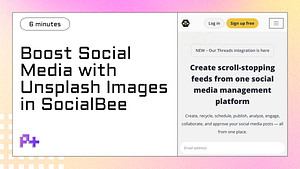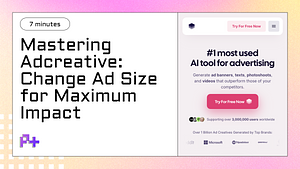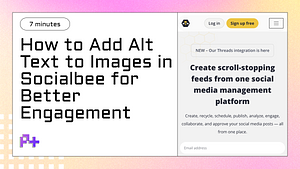Understanding the Importance of Visual Content
Visual content plays a crucial role in capturing audience attention and enhancing engagement, making it an essential element in any advertising strategy. When you add more images to a creative in Adcreative, you not only enrich the visual appeal of your advertisements but also increase their effectiveness. Studies have shown that people process images faster than text, which means that well-chosen visuals can convey your message more quickly and effectively. This is particularly important in today’s fast-paced digital landscape, where users are bombarded with information and have limited time to absorb it.
Moreover, images can evoke emotions and create a connection with your audience, which is vital for brand recognition and loyalty. By incorporating relatable and high-quality visuals into your creatives, you enhance the storytelling aspect of your marketing efforts. For instance, product images can help potential customers visualize the benefits and uses of your offerings, while lifestyle images can illustrate how your product fits into their daily lives. This not only makes your ads more relatable but also helps your audience envision themselves using your product, increasing the likelihood of conversions.
In addition to improving engagement and emotional connection, using more images in your Adcreative campaigns can also positively impact your SEO efforts. Search engines favor visually appealing content; thus, well-optimized images can improve your search rankings and drive more organic traffic to your website. By ensuring that your visuals are properly tagged with relevant keywords and descriptions, you can enhance their discoverability. Ultimately, understanding the importance of visual content and strategically adding more images to a creative in Adcreative not only boosts your advertising performance but also contributes to your overall online presence and brand growth.
Creative Ways to Use Images Online
In today's visually driven online landscape, effectively using images can significantly enhance your creative projects, especially when you aim to add more images to a creative in Adcreative. One creative way to utilize images is through storytelling. By selecting images that narrate a story or convey a message, you can engage your audience on an emotional level. For instance, instead of using generic stock photos, consider incorporating images that resonate with your brand’s narrative. This approach not only captivates viewers but also fosters a deeper connection, making your creative content more memorable.
Another innovative method is to create infographics that combine compelling visuals with informative text. Infographics are particularly effective in simplifying complex information, making it more digestible for your audience. By adding more images to a creative in Adcreative, you can design eye-catching graphics that convey key statistics or insights relevant to your topic. This not only enhances user engagement but also positions your content as a valuable resource, potentially improving your SEO rankings as users are more likely to share and link to well-crafted visuals.
Lastly, leveraging user-generated content (UGC) can be a powerful strategy to enrich your creatives. By encouraging your audience to share their images related to your brand or product, you can showcase authentic experiences that resonate with potential customers. Incorporating UGC into your Adcreative projects not only adds diversity to your visuals but also builds trust and community around your brand. This approach not only enhances your creative output but also drives engagement, as consumers tend to relate more to images created by their peers than to traditional marketing visuals.
Optimizing Images for Better Engagement
When it comes to optimizing images for better engagement in your Adcreative campaigns, it’s essential to understand the role that visuals play in capturing your audience's attention. Research has shown that ads with compelling images receive significantly higher engagement rates than those with minimal or no imagery. To truly stand out, consider incorporating a variety of images that resonate with your target demographic. This could include product shots, lifestyle images, or user-generated content that showcases real-life applications of your offering. By diversifying the types of images used, you can appeal to different segments of your audience, thereby increasing the likelihood of interaction.
Another critical aspect of image optimization is ensuring that the quality of your visuals is top-notch. High-resolution images not only look more professional but also enhance the credibility of your brand. When adding more images to a creative in Adcreative, pay attention to the file size and format, as these factors can affect load times and overall user experience. For best results, use formats like JPEG for photographs and PNG for graphics with transparent backgrounds. Additionally, utilizing image compression tools can help reduce file sizes without sacrificing quality, ensuring your ads load quickly and engagingly capture attention.
Finally, don’t underestimate the power of image SEO. When you add images to your Adcreative, ensure that you use descriptive file names and alt text that includes relevant keywords. This not only helps with accessibility for visually impaired users but also improves your chances of appearing in image search results, driving more organic traffic to your ads. By strategically optimizing your images, you can create a visually appealing ad that not only attracts clicks but also enhances your brand’s visibility and engagement in the crowded digital landscape.
Analyzing Top Posts: What Works?
When analyzing top posts to understand what works, one of the key elements to consider is the effective use of images. Adding more images to a creative in Adcreative can significantly enhance engagement and improve overall performance. Visual content not only attracts attention but also helps convey messages more effectively than text alone. Research indicates that posts featuring multiple images garner more shares and interactions, making them a vital component of a successful content strategy. By examining successful posts, it's clear that high-quality, relevant images complement the message and resonate with the target audience.
The choice of imagery is equally important. Engaging visuals that align with the theme of the post can evoke emotions and encourage users to take action. For example, using before-and-after images in health and fitness posts can illustrate transformation effectively, while infographics can simplify complex data for better comprehension. Furthermore, incorporating user-generated content, such as testimonials or photos from satisfied customers, can foster authenticity and build trust with potential clients. When you strategically add more images to a creative in Adcreative, ensure they are high-resolution, relevant, and optimized for web performance to maintain fast loading times.
In addition to aesthetics, the placement of images plays a crucial role in user experience. An effective layout will guide the viewer's eye through the content, ensuring that the images enhance rather than distract from the main message. This can be achieved by interspersing images throughout the text, breaking up long blocks of content, or using a well-structured gallery format. By thoroughly analyzing top-performing posts and adapting their image strategies, marketers can create compelling creatives that not only capture attention but also drive conversions, making the addition of images a fundamental aspect of content optimization in Adcreative.
Tips for Enhancing Your Image Strategy
When it comes to enhancing your image strategy in Adcreative, the first step is understanding the significance of visuals in advertising. Images are not just decorative elements; they are powerful tools that can convey messages, evoke emotions, and capture attention. To make the most of your image strategy, start by selecting high-quality, relevant images that resonate with your target audience. Consider the context of your campaign and choose images that reflect your brand’s identity and the message you want to communicate. This alignment between visuals and your overall creative strategy is crucial for increasing engagement and driving conversions.
Next, don’t hesitate to diversify your image types. Instead of relying solely on standard stock photos, consider integrating infographics, user-generated content, and even animated visuals. Each type of image serves a distinct purpose and can appeal to different segments of your audience. For instance, infographics are excellent for breaking down complex information, while user-generated content fosters trust and authenticity. By adding more images to your creative in Adcreative, you not only enhance visual appeal but also provide a richer and more engaging experience for your viewers. Additionally, utilizing various image formats can help you test which types resonate best, allowing for optimized performance.
Finally, pay attention to the strategic placement and optimization of your images. Use alt text effectively to enhance SEO and accessibility, ensuring that search engines can index your images while also providing context for visually impaired users. Furthermore, consider the file size and loading speed; large images can slow down your page, negatively affecting user experience. Optimize your images without compromising quality, using formats like JPEG for photographs and PNG for graphics with transparency. By strategically adding more images to your creative in Adcreative, you can significantly improve engagement, boost SEO, and create a more compelling narrative that draws your audience in.



